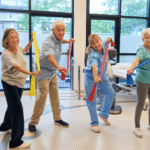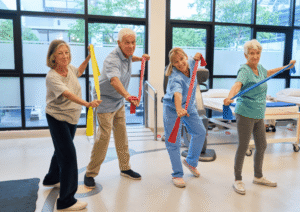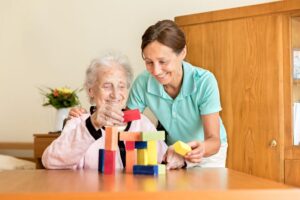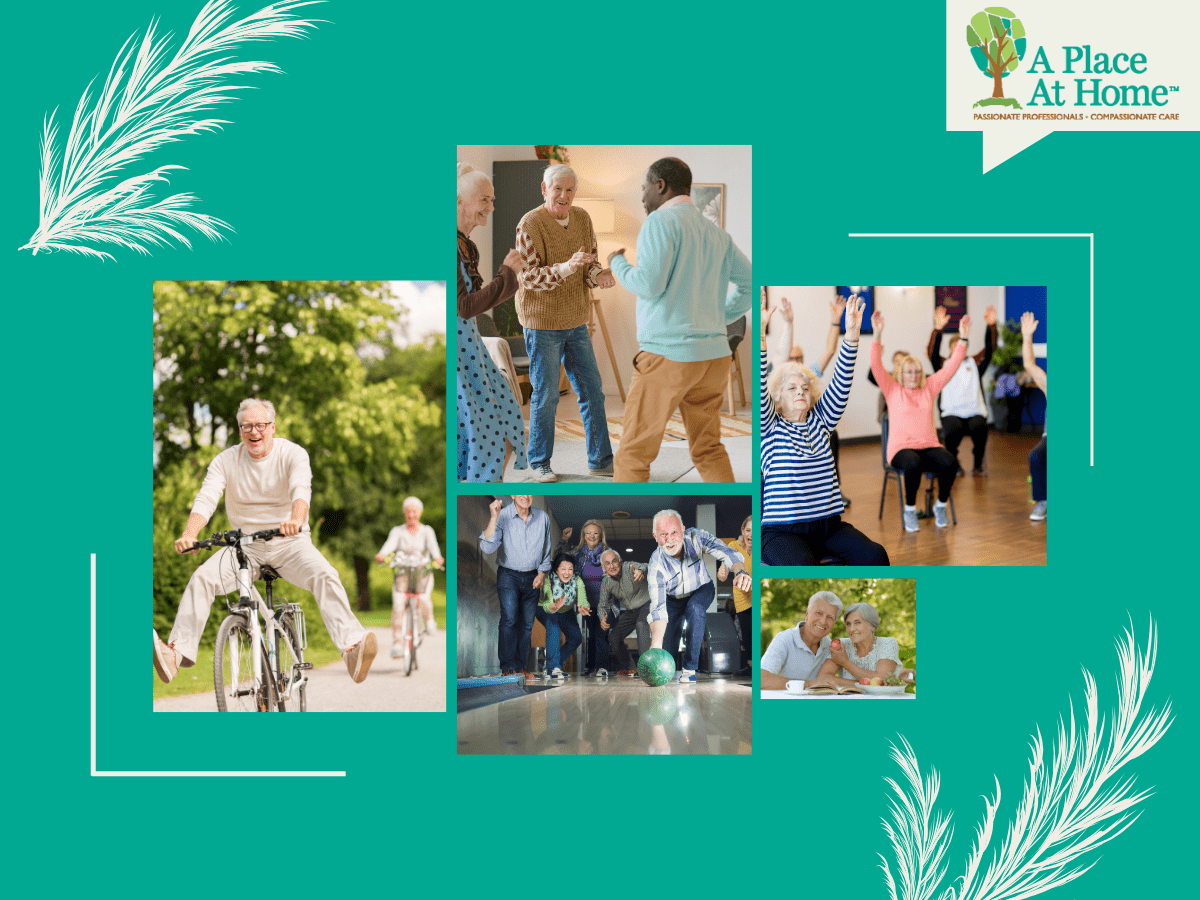
Physical activity is essential for maintaining strength, balance, and independence as we age — but staying active doesn’t always mean going to the gym. In fact, one of the most enjoyable ways for older adults to keep moving is through games that combine light exercise with social connection and fun.
For seniors receiving in-home care or support from caregivers, incorporating games into daily routines can help improve mobility, reduce loneliness, and enhance overall well-being. Here are some wonderful, low-impact game ideas that keep both the body and mind active.
Why staying active matters for seniors
As we age, our muscles naturally weaken, balance decline, and flexibility decreases — all of which can increase the risk of falls or health complications. But regular, gentle movement can reverse much of that decline.
Physical Benefits:
- Improves balance and coordination
- Enhances joint flexibility and posture
- Strengthens muscles and bones
- Boosts heart health and circulation
Mental & Emotional Benefits:
- Stimulates cognitive function
- Improves memory and mood
- Reduces anxiety and depression
- Encourages socialization and confidence
Simply put staying active helps seniors stay independent longer — and games are a fun, sustainable way to keep moving.
1. Chair exercises & seated games
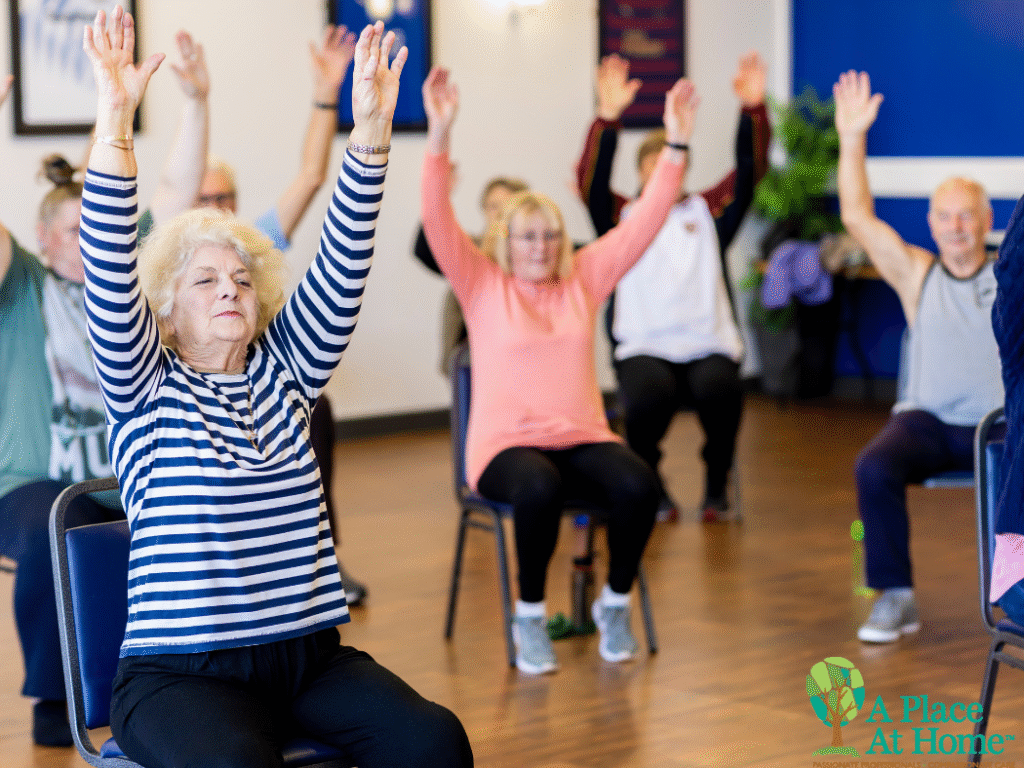
Not all exercise has to be done standing. For seniors with limited mobility, chair-based games offer a safe and comfortable way to stay active.
Examples:
Balloon Volleyball: Sit in a circle and keep a balloon in the air using hands, paddles, or even pool noodles.
Seated Toss & Catch: Use a lightweight ball and gentle throws to encourage coordination.
Follow the Leader: A caregiver can lead simple hand and arm movements for everyone to mimic.
Benefits: Improves flexibility, increases circulation, and adds an element of play to daily exercise.
2. Indoor bowling or bean bag toss
Simple, low-impact games like indoor bowling or bean bag toss (cornhole) are wonderful ways for seniors to stay active while having fun. These games promote movement, coordination, and laughter — all from the comfort and safety of home. They’re also ideal for caregivers and family members to join in, turning exercise into a shared experience rather than a chore.
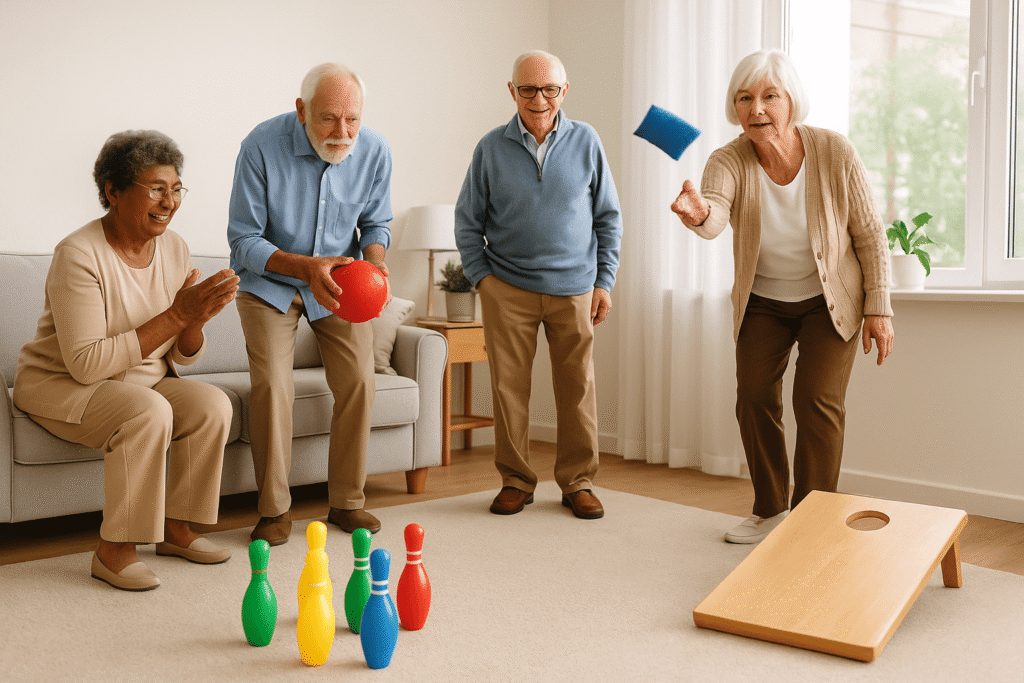
How to play
-
Set Up a Bowling Lane: Use lightweight plastic pins, empty water bottles, or even paper towel rolls as pins. A soft ball or foam ball works perfectly for rolling.
-
Try Bean Bag Toss: Place a target board, laundry basket, or buckets at different distances. Adjust the difficulty based on comfort and mobility levels.
-
Make It a Game: Keep score, play music, or offer small prizes to make it more engaging.
Why its good for seniors
These games help build balance, improve motor skills, and boost confidence with every successful throw or roll. They also encourage focus, hand-eye coordination, and light stretching — all essential for maintaining strength and stability.
3. Walking bingo
Sometimes daily walks can start to feel repetitive for seniors — especially for those spending much of their time at home or with limited social interaction. That’s why Walking Bingo is such a creative way to bring joy, movement, and mindfulness back into a familiar routine.
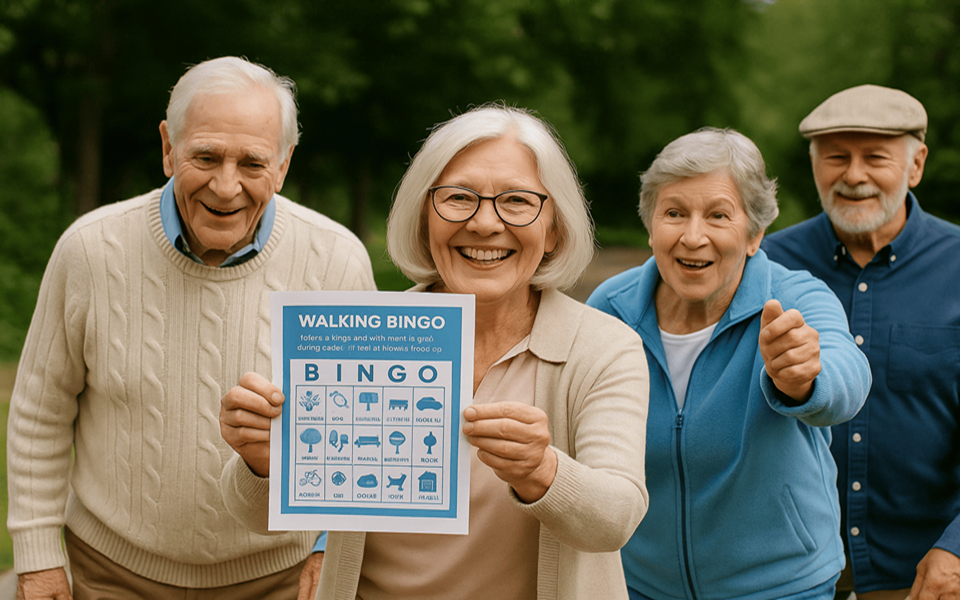
The idea is simple: create a bingo card with everyday sights to look for during a stroll — things like flowers, birds, stop signs, people walking dogs, or a red car passing by. Each time a senior spots one, they check it off their card. When the board fills up, they’ve not only completed a fun challenge but also had meaningful movement and sensory engagement along the way.
Why It’s great for seniors
For seniors who sometimes feel bored, unmotivated, or disconnected, Walking Bingo provides structure and excitement. It gives them something to look forward to, turning an ordinary activity into an interactive experience that stimulates the body and the brain.
Caregiver Tip
Caregivers can make the game even more personal and fun by:
-
Customizing cards for different days or seasons (e.g., “Find a pumpkin,” “Spot a birdhouse,” “See a neighbor waving”).
-
Adding small rewards or themes — like “Nature Day” or “Neighborhood Hunt.”
-
Encouraging friendly competition or teamwork between seniors and caregivers.
-
Taking photos of completed cards or special moments during the walk.
Each stroll becomes a chance to reconnect, laugh, and celebrate little wins. For seniors who may otherwise grow bored or restless, this playful approach turns exercise into an uplifting, shared adventure — nurturing both physical health and emotional well-being.
4. Dance & Movement games
Music has a way of reaching the heart and lifting the spirit — no matter the age. For seniors, especially those who may feel isolated or less active, dance and movement games offer a wonderful way to stay physically engaged while boosting emotional well-being. Even gentle movement to a favorite song can make a big difference in mood, balance, and confidence.
Dancing doesn’t need to be complex or strenuous. Simple rhythm-based games like “Move to the Beat”, chair dancing, or rhythm scarf games can be done alone, with a caregiver, or in small groups. What matters most is the joy of movement and connection that music inspires.
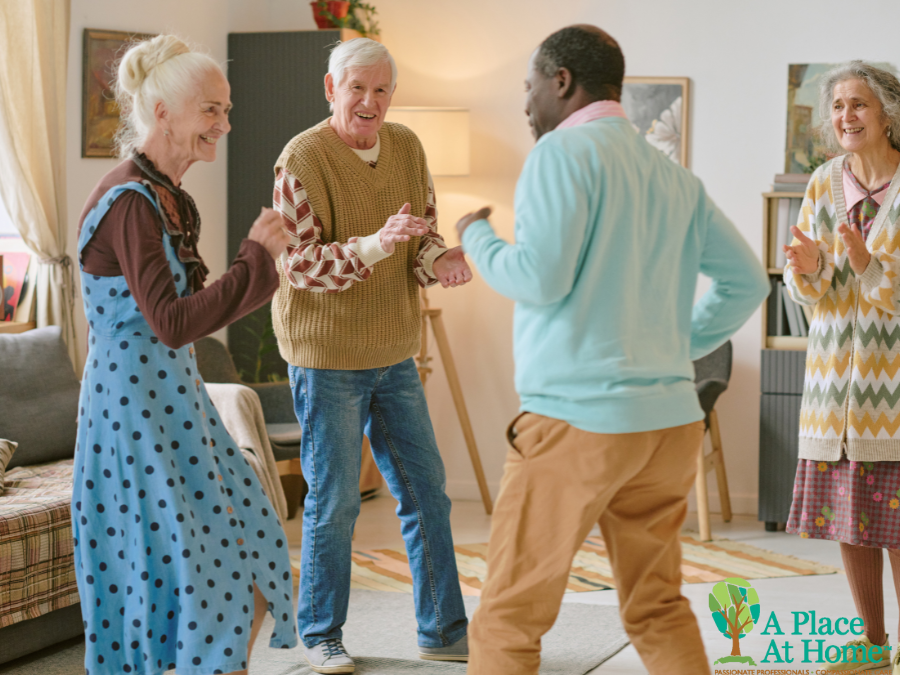
Ideas:
- Play favorite songs and encourage simple step movements or swaying to the beat.
- Use scarves or ribbons for added motion and fun.
- Group dance sessions or caregiver-led “movement moments” can turn routine exercise into joyful connection.
Benefits: Increases energy, reduces stress, and promotes better posture and coordination.
5. Gardening games
Gardening is one of the most therapeutic forms of movement. Even light tasks like planting flowers, watering, or picking herbs provide physical activity disguised as play.
Caregivers can turn this into a friendly gardening game, such as:
- “Who can find the first bloom?”
- “Name that plant!” quizzes
- Creating mini garden arrangements together
Benefits: Encourages movement, outdoor time, and sensory stimulation — while offering a calming, purposeful activity.
6. Group Games for care settings or family gatherings
If you’re part of an assisted living community or have a caregiver visiting at home, group games can foster laughter, friendship, and healthy competition.
Great options include:
- Balloon Tennis – Played indoors with paddles or hands.
- Shuffleboard or Carpet Curling – Perfect for all skill levels.
- Ring Toss or Horseshoes – Encourages coordination and balance.
- Scavenger Hunts – Indoors or outdoors, customized for safety and mobility.
Benefits: Social engagement is just as important as physical movement. Group games bring joy and belonging — two essential ingredients for emotional health.
7. Brain-Boosting games with movement
Cognitive and physical health go hand in hand — especially for seniors living with Alzheimer’s disease, dementia, or other memory challenges. Combining mental stimulation with light movement helps keep the mind sharp and the body active, while also sparking joy and engagement.
These gentle, low-stress activities can be adapted to each person’s comfort level and are perfect for in-home caregivers to facilitate.
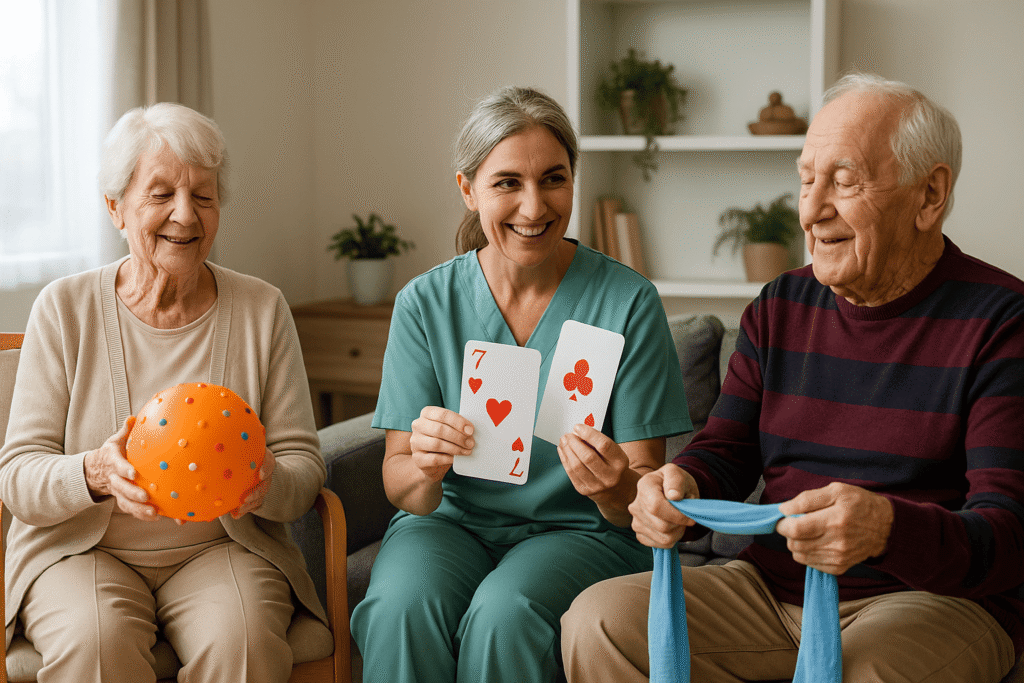
Examples include:
- Trivia Toss: Throw a ball back and forth — whoever catches it answers a trivia question.
- Color or Object Sorting Races: Match or sort items by color or shape — great for hand-eye coordination and visual memory.
- Alphabet Walks: Each step or turn includes naming something that starts with the next letter of the alphabet.
- Memory Match with Motion: After matching cards, do a small stretch or movement.
Why these games help
These simple, structured activities:
- Encourage mental focus and recall
- Strengthen coordination and reflexes
- Provide sensory stimulation and reduce restlessness
- Support emotional well-being by creating joyful interaction
These games keep both body and mind sharp while promoting coordination and laughter.
8. Indoor vs. Outdoor Games: Choosing the right activity
| Indoor Games | Outdoor Games |
|---|---|
| Chair exercises | Walking bingo |
| Bean bag toss | Gardening |
| Balloon volleyball | Bocce ball |
| Trivia toss | Shuffleboard |
| Stretch & sing | Outdoor dance circle |
9. Adaptive games for all abilities
Every senior is different. Caregivers should tailor games based on ability, mobility, and comfort.
For Wheelchair Users:
- Seated yoga, balloon volleyball, table-top ring toss
For Seniors Recovering from Surgery:
- Gentle stretching or light resistance band activities
For Dementia or Alzheimer’s Care:
- Simple games with repetition, color matching, or music cues
Key Tip: Focus on enjoyment and safety over performance — movement, no matter how small, matters.
The caregiver’s role in encouraging physical activity
Having the right support makes all the difference when it comes to keeping seniors active. Many older adults want to move more but may feel unsure where to start or worry about safety. That’s where a compassionate, well-trained caregiver can play a vital role.
Caregivers not only provide physical assistance but also create a sense of motivation, safety, and confidence — turning everyday moments into opportunities for gentle movement. Whether it’s helping a client stretch, take short walks, or enjoy fun games, the caregiver’s encouragement can transform physical activity into something enjoyable and sustainable.
How caregivers help seniors stay active
- Plan daily movement breaks: Small, scheduled moments of activity — like stretching between meals or walking to the mailbox — keep seniors consistently moving.
- Adapt games to ability level: Caregivers tailor each activity to match the senior’s comfort and mobility, ensuring safety and inclusion for everyone.
- Create variety to prevent boredom: Mixing up activities — from balloon volleyball to light yoga — keeps exercise fun and engaging.
- Supervise for safety: Caregivers watch for signs of fatigue, provide balance support, and make sure the environment is clutter-free and safe.
- Provide motivation and praise: A kind word or smile goes a long way in helping seniors feel proud of their efforts and motivated to continue.
Emotional & mental benefits of active games
Staying active isn’t just about keeping the body strong — it’s also about nurturing the mind and spirit. Games that involve movement create moments of laughter, connection, and accomplishment, which are just as important to healthy aging as exercise itself.
For many seniors, especially those receiving personal or companion care, these playful activities can lift the mood, ease loneliness, and bring a renewed sense of joy to daily life.
Emotional benefits of active games
- Reduce feelings of isolation: Playing with caregivers, friends, or family creates meaningful social interactions that fight loneliness.
- Encourage social bonding: Shared laughter and teamwork build relationships and a sense of belonging.
- Boost self-esteem: Achieving small goals or mastering a new game helps seniors feel capable and confident.
- Offer a sense of accomplishment: Completing activities gives seniors purpose and pride in staying active and engaged.
Beyond physical movement, these emotional benefits foster happiness, motivation, and overall quality of life — helping seniors truly thrive at home or within their care community.
Staying Active, Staying Happy
Movement is medicine — and when paired with laughter and connection, it becomes joy. For seniors, staying physically active through games promotes strength, independence, and happiness. And for in home caregivers, these activities are an opportunity to nurture both body and spirit.


